Seiichi Uchida
Instance-wise Supervision-level Optimization in Active Learning
Mar 09, 2025Abstract:Active learning (AL) is a label-efficient machine learning paradigm that focuses on selectively annotating high-value instances to maximize learning efficiency. Its effectiveness can be further enhanced by incorporating weak supervision, which uses rough yet cost-effective annotations instead of exact (i.e., full) but expensive annotations. We introduce a novel AL framework, Instance-wise Supervision-Level Optimization (ISO), which not only selects the instances to annotate but also determines their optimal annotation level within a fixed annotation budget. Its optimization criterion leverages the value-to-cost ratio (VCR) of each instance while ensuring diversity among the selected instances. In classification experiments, ISO consistently outperforms traditional AL methods and surpasses a state-of-the-art AL approach that combines full and weak supervision, achieving higher accuracy at a lower overall cost. This code is available at https://github.com/matsuo-shinnosuke/ISOAL.
Self-Relaxed Joint Training: Sample Selection for Severity Estimation with Ordinal Noisy Labels
Oct 29, 2024Abstract:Severity level estimation is a crucial task in medical image diagnosis. However, accurately assigning severity class labels to individual images is very costly and challenging. Consequently, the attached labels tend to be noisy. In this paper, we propose a new framework for training with ``ordinal'' noisy labels. Since severity levels have an ordinal relationship, we can leverage this to train a classifier while mitigating the negative effects of noisy labels. Our framework uses two techniques: clean sample selection and dual-network architecture. A technical highlight of our approach is the use of soft labels derived from noisy hard labels. By appropriately using the soft and hard labels in the two techniques, we achieve more accurate sample selection and robust network training. The proposed method outperforms various state-of-the-art methods in experiments using two endoscopic ulcerative colitis (UC) datasets and a retinal Diabetic Retinopathy (DR) dataset. Our codes are available at https://github.com/shumpei-takezaki/Self-Relaxed-Joint-Training.
Can GPTs Evaluate Graphic Design Based on Design Principles?
Oct 11, 2024Abstract:Recent advancements in foundation models show promising capability in graphic design generation. Several studies have started employing Large Multimodal Models (LMMs) to evaluate graphic designs, assuming that LMMs can properly assess their quality, but it is unclear if the evaluation is reliable. One way to evaluate the quality of graphic design is to assess whether the design adheres to fundamental graphic design principles, which are the designer's common practice. In this paper, we compare the behavior of GPT-based evaluation and heuristic evaluation based on design principles using human annotations collected from 60 subjects. Our experiments reveal that, while GPTs cannot distinguish small details, they have a reasonably good correlation with human annotation and exhibit a similar tendency to heuristic metrics based on design principles, suggesting that they are indeed capable of assessing the quality of graphic design. Our dataset is available at https://cyberagentailab.github.io/Graphic-design-evaluation .
Deep Bayesian Active Learning-to-Rank with Relative Annotation for Estimation of Ulcerative Colitis Severity
Sep 10, 2024



Abstract:Automatic image-based severity estimation is an important task in computer-aided diagnosis. Severity estimation by deep learning requires a large amount of training data to achieve a high performance. In general, severity estimation uses training data annotated with discrete (i.e., quantized) severity labels. Annotating discrete labels is often difficult in images with ambiguous severity, and the annotation cost is high. In contrast, relative annotation, in which the severity between a pair of images is compared, can avoid quantizing severity and thus makes it easier. We can estimate relative disease severity using a learning-to-rank framework with relative annotations, but relative annotation has the problem of the enormous number of pairs that can be annotated. Therefore, the selection of appropriate pairs is essential for relative annotation. In this paper, we propose a deep Bayesian active learning-to-rank that automatically selects appropriate pairs for relative annotation. Our method preferentially annotates unlabeled pairs with high learning efficiency from the model uncertainty of the samples. We prove the theoretical basis for adapting Bayesian neural networks to pairwise learning-to-rank and demonstrate the efficiency of our method through experiments on endoscopic images of ulcerative colitis on both private and public datasets. We also show that our method achieves a high performance under conditions of significant class imbalance because it automatically selects samples from the minority classes.
* 14 pages, 8 figures, accepted in Medical Image Analysis 2024
Learning from Partial Label Proportions for Whole Slide Image Segmentation
May 15, 2024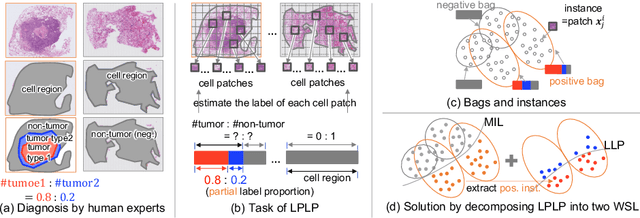

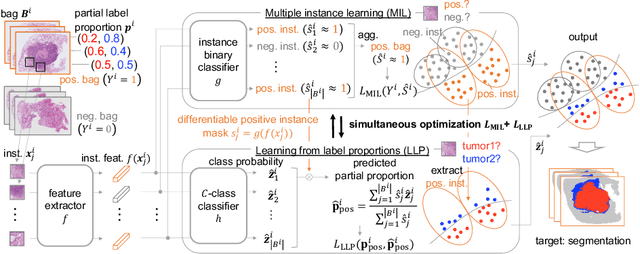
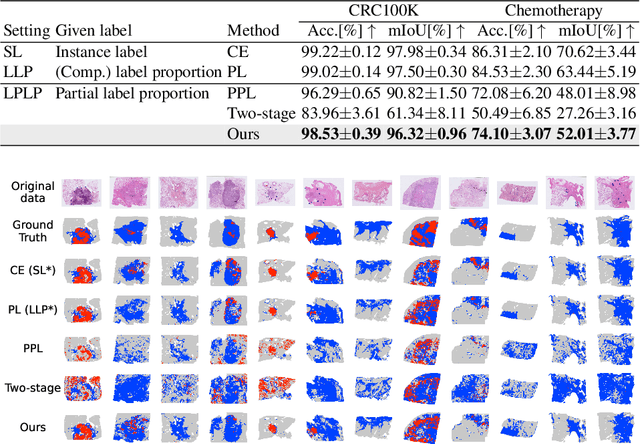
Abstract:In this paper, we address the segmentation of tumor subtypes in whole slide images (WSI) by utilizing incomplete label proportions. Specifically, we utilize `partial' label proportions, which give the proportions among tumor subtypes but do not give the proportion between tumor and non-tumor. Partial label proportions are recorded as the standard diagnostic information by pathologists, and we, therefore, want to use them for realizing the segmentation model that can classify each WSI patch into one of the tumor subtypes or non-tumor. We call this problem ``learning from partial label proportions (LPLP)'' and formulate the problem as a weakly supervised learning problem. Then, we propose an efficient algorithm for this challenging problem by decomposing it into two weakly supervised learning subproblems: multiple instance learning (MIL) and learning from label proportions (LLP). These subproblems are optimized efficiently in the end-to-end manner. The effectiveness of our algorithm is demonstrated through experiments conducted on two WSI datasets.
Test-Time Augmentation for Traveling Salesperson Problem
May 08, 2024Abstract:We propose Test-Time Augmentation (TTA) as an effective technique for addressing combinatorial optimization problems, including the Traveling Salesperson Problem. In general, deep learning models possessing the property of invariance, where the output is uniquely determined regardless of the node indices, have been proposed to learn graph structures efficiently. In contrast, we interpret the permutation of node indices, which exchanges the elements of the distance matrix, as a TTA scheme. The results demonstrate that our method is capable of obtaining shorter solutions than the latest models. Furthermore, we show that the probability of finding a solution closer to an exact solution increases depending on the augmentation size.
Pseudo-label Learning with Calibrated Confidence Using an Energy-based Model
Apr 15, 2024
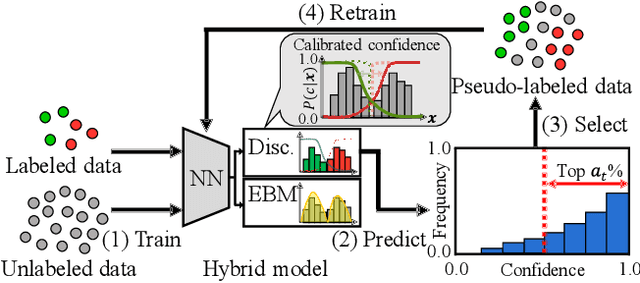
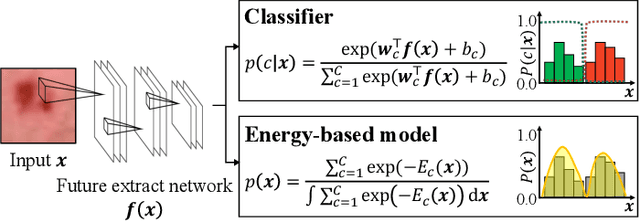
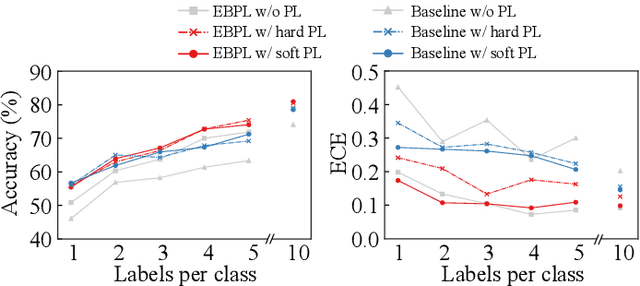
Abstract:In pseudo-labeling (PL), which is a type of semi-supervised learning, pseudo-labels are assigned based on the confidence scores provided by the classifier; therefore, accurate confidence is important for successful PL. In this study, we propose a PL algorithm based on an energy-based model (EBM), which is referred to as the energy-based PL (EBPL). In EBPL, a neural network-based classifier and an EBM are jointly trained by sharing their feature extraction parts. This approach enables the model to learn both the class decision boundary and input data distribution, enhancing confidence calibration during network training. The experimental results demonstrate that EBPL outperforms the existing PL method in semi-supervised image classification tasks, with superior confidence calibration error and recognition accuracy.
Total Disentanglement of Font Images into Style and Character Class Features
Mar 19, 2024Abstract:In this paper, we demonstrate a total disentanglement of font images. Total disentanglement is a neural network-based method for decomposing each font image nonlinearly and completely into its style and content (i.e., character class) features. It uses a simple but careful training procedure to extract the common style feature from all `A'-`Z' images in the same font and the common content feature from all `A' (or another class) images in different fonts. These disentangled features guarantee the reconstruction of the original font image. Various experiments have been conducted to understand the performance of total disentanglement. First, it is demonstrated that total disentanglement is achievable with very high accuracy; this is experimental proof of the long-standing open question, ``Does `A'-ness exist?'' Hofstadter (1985). Second, it is demonstrated that the disentangled features produced by total disentanglement apply to a variety of tasks, including font recognition, character recognition, and one-shot font image generation.
NoiseCollage: A Layout-Aware Text-to-Image Diffusion Model Based on Noise Cropping and Merging
Mar 06, 2024Abstract:Layout-aware text-to-image generation is a task to generate multi-object images that reflect layout conditions in addition to text conditions. The current layout-aware text-to-image diffusion models still have several issues, including mismatches between the text and layout conditions and quality degradation of generated images. This paper proposes a novel layout-aware text-to-image diffusion model called NoiseCollage to tackle these issues. During the denoising process, NoiseCollage independently estimates noises for individual objects and then crops and merges them into a single noise. This operation helps avoid condition mismatches; in other words, it can put the right objects in the right places. Qualitative and quantitative evaluations show that NoiseCollage outperforms several state-of-the-art models. These successful results indicate that the crop-and-merge operation of noises is a reasonable strategy to control image generation. We also show that NoiseCollage can be integrated with ControlNet to use edges, sketches, and pose skeletons as additional conditions. Experimental results show that this integration boosts the layout accuracy of ControlNet. The code is available at https://github.com/univ-esuty/noisecollage.
Cross-Domain Image Conversion by CycleDM
Mar 05, 2024Abstract:The purpose of this paper is to enable the conversion between machine-printed character images (i.e., font images) and handwritten character images through machine learning. For this purpose, we propose a novel unpaired image-to-image domain conversion method, CycleDM, which incorporates the concept of CycleGAN into the diffusion model. Specifically, CycleDM has two internal conversion models that bridge the denoising processes of two image domains. These conversion models are efficiently trained without explicit correspondence between the domains. By applying machine-printed and handwritten character images to the two modalities, CycleDM realizes the conversion between them. Our experiments for evaluating the converted images quantitatively and qualitatively found that ours performs better than other comparable approaches.
 Add to Chrome
Add to Chrome Add to Firefox
Add to Firefox Add to Edge
Add to Edge